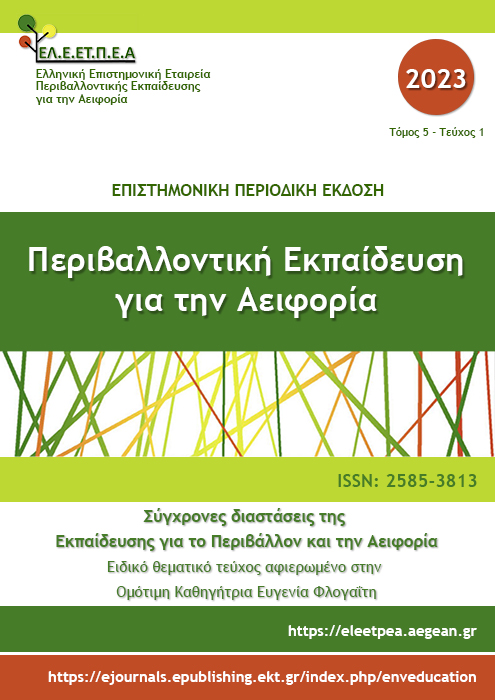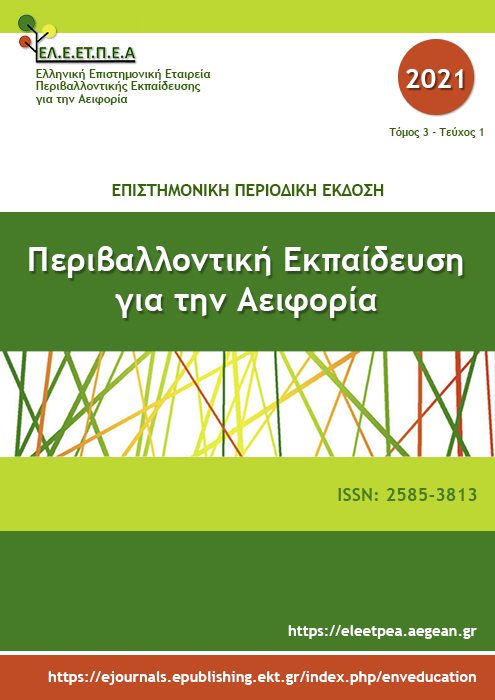Δημιουργικότητα και εκπαίδευση για το περιβάλλον και την αειφορία: μια γόνιμη και εξελισσόμενη σχέση
Abstract
Amabile, T. M. (1982). Social psychology of creativity: A consensual assessment technique. Journal of Personality and Social Psychology, 43(5), 997–1013. http://dx.doi.org/10.1037/0022-3514.43.5.997.
Beghetto, R. A. (2010). Creativity in the Classroom. In J. C. Kaufman & R. J. Sternberg (Eds.). The Cambridge Handbook of Creativity (pp. 447-466). New York: Cambridge University Press.
Beghetto, R. A., & Kaufman, J. C. (2007). Toward a broader conception of creativity: A case for “mini-c” creativity. Psychology of Aesthetics, Creativity, and the Arts, 1(2), 73–79. https://doi.org/10.1037/1931-3896.1.2.73.
Boden, M. (2001). Creativity and knowledge. In A. Craft, B. Jeffrey & M. Leibling (Eds.). Creativity in education (pp. 95-102). London: Continuum.
Burnard, P. (2011). Constructing assessment for creative learning. In J. Sefton-Green, P. Thomson, K. Jones & L. Bresler (Eds.). The Routledge International Handbook of Creative Learning (pp.140-149). Oxon: Routledge.
Burnard, P., Craft, A., Cremin, T. with Duffy, B., Hanson, R., Keene, J., Haynes, L., Burns, D. (2006). Documenting “possibility thinking”: a journey of collaborative enquiry. International Journal of Early Years Education, 14(3), 243-262. https://doi.org/10.1080/09669760600880001.
Cheng, V. M. Y. (2019). Developing individual creativity for environmental sustainability: Using an everyday theme in higher education. Thinking Skills and Creativity, 33. https://doi.org/10.1016/j.tsc.2019.05.001
Council of the Earth (1993). Environmental Education for Sustainable Societies and Global Responsibility. International NGO Treaty, Global Forum, Rio de Janeiro, Brazil, 9 June 1992.
Craft, A. (2001). Little c Creativity. In A. Craft, B., Jeffrey & M. Leibling (Eds.). Creativity in Education (pp.45-61). London: Continuum.
Craft, A. (2002). Creativity and Early Years Education: A lifewide foundation. London, New York: Continuum.
Craft, A. (2003). Creative Thinking in the Early Years of Education. Early Years, 23(2), 143-154. https://doi.org/10.1080/09575140303105.
Craft, A. (2005). Creativity in Schools: Tensions and Dilemmas. Oxon: Routledge.
Craft, A. (2007). Creativity and Possibility in the Early Years. 1-9, Retrieved August 2012, from http://www.tactyc.org.uk/pdfs/Reflection-craft.pdf.
Craft, A. (2011). Approaches to creativity in education in the United Kingdom. In J. Sefton-Green, P. Thomson, K. Jones & L. Bresler (Eds.). The Routledge International Handbook of Creative Learning (pp.129-139). Oxon: Routledge.
Craft, A., Cremin, T., Burnard, P., & Chappell, K. (2007). Teacher stance in creative learning: A study of progression. Thinking Skills and Creativity, 2(2), 136–147. https://doi.org/10.1016/j.tsc.2007.09.003.
Craft, A., Cremin, T., Burnard, P., Dragovic, T., & Chappell, K. (2013). Possibility thinking: culminative studies of an evidence-based concept driving creativity? Education, 41(5), 538–556. https://doi.org/10.1080/03004279.2012.656671.
Craft, A., McConnon, L., & Matthews, A. (2012). Child-initiated play and professional creativity: Enabling four-year-olds’ possibility thinking. Thinking Skills and Creativity, 7(1), 48–61. https://doi.org/10.1016/j.tsc.2011.11.005.
Cremin, T., Burnard, P., Craft, A. (2006). Pedagogy and possibility thinking in the early years. Thinking Skills and Creativity, 1(2), 108-119. https://doi.org/10.1016/j.tsc.2006.07.001.
Cropley, A. J., & Urban, K. K. (2000). Programs and strategies for nurturing creativity. In K. A. Heller, F. J. Mönks, R. Subotnik & R. J. Sternberg (Eds.). International Handbook of Giftedness and Talent (pp. 481-494). Oxford: Elsevier.
Cropley, A., & Cropley, D. (2008). Resolving the paradoxes of creativity: An extended phase model. Cambridge Journal of Education, 38(3), 355–373. https://doi.org/10.1080/03057640802286871.
Cropley, D., & Cropley, A. (2010). Functional creativity. In J. C. Kaufman & R. J. Sternberg (Eds.). The Cambridge Handbook of Creativity (pp. 301–318). Cambridge: Cambridge University.
Csikszentmihalyi, M. (1996). Creativity: Flow and the Psychology of Discovery and Invention. New York: Harper Collins Publishers.
D’orville, H. (2019). The Relationship between Sustainability and Creativity Cadmus, 4, 65–73.
Daskolia, M., Dimos, A., & Kampylis, P. G. (2012). Secondary teachers’ conceptions of creative thinking within the context of environmental education. International Journal of Environmental and Science Education, 7(2), 269–290. Retrieved January 2013, from https://files.eric.ed.gov/fulltext/EJ990520.pdf.
Daskolia, M., Makri, K., & Kynigos, C. (2014). Fostering collaborative creativity in learning about urban sustainability through digital storytelling. In G. Futschek, & C. Kynigos (Eds.). Constructionism and Creativity: Proceedings of the ‘Constructionism 2014’ International Conference, Vienna, Austria, 19-23 August (pp. 357-366). Vienna: Österreichische Computer Gesellschaft.
Faulkner, D., Coates, E., Craft, A., & Duffy, B. (2006). Creativity and cultural innovation in early childhood education. International Journal of Early Years Education, 14(3), 191–199. https://doi.org/10.1080/09669760600879839.
Fischer, B. M. (2020). Developing and sustaining creativity: Creative processes in Canadian junior college teachers. Thinking Skills and Creativity, 38, 100754. https://doi.org/10.1016/j.tsc.2020.100754
Fürst, G., & Grin, F. (2018). A comprehensive method for the measurement of everyday creativity. Thinking Skills and Creativity, 28, 84–97. https://doi.org/10.1016/j.tsc.2018.03.007
Gallagher, J., & Aschner, M. (1963). A Preliminary Report on Analysis of Classroom Interaction. Merrill-Palmer Quarterly of Behavior and Development, 9(3), 183-194. www.jstor.org/stable/23082786.
Gruszka, A. & Tang, M. (2017). The 4P’s Creativity Model and its application in different fields. In M. Tang, & C. H. Werner (Eds.). Handbook of the management of creativity and innovation: Theory and practice (pp.51-71). Singapore: World Scientific Press. Retrieved September 2018, from https://www.researchgate.net/publication/316644392_The_4P's_Creativity_Model_and_its_application_in_different_fields.
Guildford, J. P. (1950). Creativity. American Psychologist, 5(9), 444-454. http://dx.doi.org/10.1037/h0063487.
Heilmann. G. & Korte, B. (2010). The Role of Creativity and Innovation in School Curricula in the EU27: A content analysis of curricula documents. Seville: European Commission, Joint Research Centre (JRC), Institute for Prospective Technological Studies.
Hensley, N. (2020). Educating for sustainable development: cultivating creativity through mindfulness. J. Clean. Prod. 243. https://doi.org/10.1016/j.jclepro.2019.118542.
Howlett, C., Ferreira, J. and Blomfield, J. (2016). Teaching sustainable development in higher education. International Journal of Sustainability in Higher Education, 17(3), 1-17. https://doi.org/10.1108/IJSHE-07-2014-0102.
Jindal-Snape, D., Davies, D., Collier, C., Howe, A., Digby, R., & Hay, P. (2013). The impact of creative learning environments on learners: a systematic literature review. Improving Schools, 16(1), 21-31. https://doi.org/10.1177/1365480213478461.
Καλαφάτη, Μ. (2020). Προσεγγίζοντας τη δημιουργικότητα των παιδιών μέσα από τη διερεύνηση ενός περιβαλλοντικού ζητήματος στο νηπιαγωγείο. Διδακτορική Διατριβή, Τμήμα Εκπαίδευσης και Αγωγής στην Προσχολική Ηλικία, Εθνικό και Καποδιστριακό Πανεπιστήμιο Αθηνών.
Kampylis, P. & Valtanen, J. (2010). Redefining Creativity - Analyzing Definitions, Collocations, and Consequences. Journal of Creative Behavior 44(3), 191-214. https://doi.org/10.1002/j.2162-6057.2010.tb01333.x. Retrieved September 2018, from https://www.researchgate.net/publication/221675608_Redefining_Creativity_-_Analyzing_Definitions_Collocations_and_Consequences.
Kampylis, P., Berki, E. & Saariluoma, P. (2009). In-service and prospective teachers’ conceptions of creativity. Thinking Skills and Creativity 4(1). 15-29. https://doi.gr/10.1016/j;tsc.2008.10.001
Kaufman, J. C., & Beghetto, R. A. (2009). Beyond Big and Little : The Four C Model of Creativity, 13(1), 1–12. https://doi.org/10.1037/a0013688.
Kim, S., Choe, I., & Kaufman, J. C. (2019). The development and evaluation of the effect of creative problem-solving program on young children’s creativity and character. Thinking Skills and Creativity, 33, 100590. https://doi.org/10.1016/j.tsc.2019.100590
Kozbelt, A., Beghetto, R.A. & Runco. M.A. (2010). Theories of Creativity. In J. C. Kaufman & R. J. Sternberg (Eds.). The Cambridge Handbook of Creativity (pp. 20-47). New York: Cambridge University Press.
Long, H. (2014). An Empirical Review of Research Methodologies and Methods in Creativity Studies (2003–2012). Creativity Research Journal, 26(4), 427–438. https://doi.org/10.1080/10400419.2014.961781
Μπιρμπίλη, Μ. (2008). Προς μια Παιδαγωγική του διαλόγου: Η σημασία και ο ρόλος των ερωτήσεων στην Προσχολική Εκπαίδευση. Αθήνα: Gutenberg.
Mróz, A. & Ocetkiewicz, I. (2021). Creativity for Sustainability: How Do Polish Teachers Develop Students’ Creativity Competence? Analysis of Research Results. Sustainability, 13, 571. https://doi.org/10.3390/su13020571.
Mróz, A., Ocetkiewicz, I., & Walotek-Ściańska, K. (2018). Which Media do Polish Teachers Use to Support Sustainable Development among Students? Analysis of Research. Sustainability, 10(5), 1496. https://doi.org/10.3390/su10051496
Mullet, D. R., Willerson, A., N. Lamb, K., & Kettler, T. (2016). Examining teacher perceptions of creativity: A systematic review of the literature. Thinking Skills and Creativity, 21, 9–30. https://doi.org/10.1016/j.tsc.2016.05.001
Mumford, M. D. (2003). Where Have We Been, Where Are We Going? Taking Stock in Creativity Research, Creativity Research Journal, 15(2-3), 107-120, DOI: https://doi.org.10.1080/10400419.2003.9651403 .
National Advisory Committee on Creative and Cultural Education (NACCCE) (1999). All Our Futures: Creativity, Culture and Education. Retrieved February 2019, from http://citeseerx.ist.psu.edu/viewdoc/download?doi=10.1.1.115.1660&rep=rep1&type=pdf.
Ξανθάκου, Γ. (2011). Δημιουργικότητα και Καινοτομία στο Σχολείο και την Κοινωνία. Αθήνα: Διάδραση.
Patston, T. J., Kaufman, J. C., Cropley, A. J., & Marrone, R. (2021). What Is Creativity in Education? A Qualitative Study of International Curricula. Journal of Advanced Academics, 1932202X2097835. https://doi.org/10.1177/1932202X20978356
Plucker, J. A., Beghetto, R. A., & Dow, G. T. (2004). Why isn’t creativity more important to educational psychologists? Potentials, pitfalls, and future directions in creativity research. Educational Psychologist, 39(2), 83-96. http://dx.doi.org/10.1207/s15326985ep3902_1.
Qualifications and Curriculum Authority (QCA) (2004). Creativity: Find it, Promote it—Promoting Pupils’ Creative Thinking and Behavior Across the Curriculum at Key Stages 1, 2 and 3— Practical Materials for Schools. London: Qualifications and Curriculum Authority. Retrieved December 2011, from https://www.literacyshed.com/uploads/1/2/5/7/12572836/1847211003.pdf.
Rhodes, M. (1961). An Analysis of Creativity. The Phi Delta Kappan, 42(7), 305-310. Retrieved July 2018, from http://www.jstor.org/stable/20342603.
Richards, R. (2010). Everyday Creativity: Process and Way of Life – Four Key Issues. In J. C. Kaufman & R. J. Sternberg (Eds.). The Cambridge Handbook of Creativity (pp. 189-215). New York: Cambridge University Press.
Rodríguez, M., Kohen, R. & Delval, J. (2015). Children’s and adolescents’ thoughts on pollution: cognitive abilities required to understand environmental systems. Environmental Education Research 21(1), 76-91. https://doi.org/10.1080/13504622.2013.862613.
Runco, M. A. (2003). Education for Creative Potential. Scandinavian Journal of Educational Research, 47(3), 317–324. https://doi.org/10.1080/00313830308598.
Runco, M. A. (2004). Creativity. Annual Review of Psychology, 55, 657–687. Retrieved February 2019, from http://people.wku.edu/richard.miller/creativity.pdf.
Saleh & Brem (2023). Creativity for sustainability: An integrative literature review. Journal of Cleaner Production, Volume 388, https://doi.org/10.1016/j.jclepro.2023.135848.
Sandri, O. J. (2013). Exploring the role and value of creativity in education for sustainability. Environmental Education Research, 19(6), 765–778. https://doi.org/10.1080/13504622.2012.749978.
Simonton, D. K. (2012). Taking the U.S. Patent Office criteria seriously: A quantitative three criterion creativity definition and its implications. Creativity Research Journal, 24(2–3), 97–106. https://doi.org/10.1080/10400419.2012.676974.
Smith, J.K. & Smith, L.F. (2010). Educational Creativity. In J. C. Kaufman & R. J. Sternberg (Eds.). The Cambridge Handbook of Creativity (pp. 250-264). New York: Cambridge University Press.
Song, Y. I. K. (2009). Media art remix: a tool for social action. International Journal of Education through Art, 5(2 and 3), 229-240. https://doi.org/10.1386/eta.5.2and3.229/1.
Stein, M. I. (1953). Creativity and Culture, The Journal of Psychology, 36(2), 311-322, DOI: https://doi.org/10.1080/00223980.1953.9712897.
Sternberg, R. J. (2006). Introduction. In J.C. Kaufman and R. J. Sternberg (Eds.). The International Handbook of Creativity (pp. 1–9). Cambridge: Cambridge University Press.
Sternberg, R. J., & Lubart, T. (1999). The concept of creativity: Prospects and paradigms. In R. Sternberg (Ed.). Handbook of Creativity (pp. 3-15). Cambridge, U.K.: Cambridge University Press.
Tan, E. & So, H-J. (2019). Role of environmental interaction in interdisciplinary thinking: from knowledge resources perspectives. The Journal of Environmental Education, 50(2), 113-130, DOI: https://doi.org/10.1080/00958964.2018.1531280
Torrance, E. P. (1966). The Torrance Tests of Creative Thinking – Norms-Technical Manual Research Edition – Verbal Tests, Forms A and B – Figural Tests, Forms A and B. Princeton NJ: Personnel Press.
Tran, T. B. L., Ho, T. N., Mackenzie, S. V., & Le, L. K. (2017). Developing assessment criteria of a lesson for creativity to promote teaching for creativity. Thinking Skills and Creativity, 25, 10–26. https://doi.org/10.1016/j.tsc.2017.05.006
UNESCO (2002). Education for Sustainability, From Rio to Johannesburg: Lessons learnt from a Decade of Commitment, Paris: UNESCO. Retrieved January 2019, from https://www.ramsar.org/sites/default/files/documents/library/education_for_sustainability_unesco.pdf.
UNESCO (2005). UN Decade of Education for Sustainable Development 2005-2014: The DESD at a glance. Paris: UNESCO. Retrieved July 2017, from http://unesdoc.unesco.org/images/0014/001416/141629e.pdf.
UNESCO (2012). Shaping the Education of Tomorrow: 2012 Full-length Report on the UN Decade of Education for Sustainable Development. Paris: UNESCO. Retrieved August 2017, from https://sustainabledevelopment.un.org/content/documents/919unesco1.pdf.
UNESCO. (2015). Rethinking education: Towards a global common good? Paris: UNESCO. Retrieved January 2019, from http://unesdoc.unesco.org/images/0023/002325/232555e.pdf.
Wallas, G. (2014). The Art of Thought. England: Solis Press.
Zamora-Polo, F., & Sánchez-Martín, J. (2019). Teaching for a Better World. Sustainability and Sustainable Development Goals in the Construction of a Change-Maker University. Sustainability, 11(15), 4224. https://doi.org/10.3390/su11154224
Article Details
- How to Cite
-
Καλαφάτη Μ. (2023). Δημιουργικότητα και εκπαίδευση για το περιβάλλον και την αειφορία: μια γόνιμη και εξελισσόμενη σχέση. Environmental Education for Sustainability, 5(1), 80–94. https://doi.org/10.12681/ees.35764
- Section
- Articles

This work is licensed under a Creative Commons Attribution-NonCommercial-ShareAlike 4.0 International License.
Authors retain copyright and grant the journal right of first publication with the work simultaneously licensed under a CC-BY-NC-SA that allows others to share the work with an acknowledgement of the work's authorship and initial publication in this journal.



